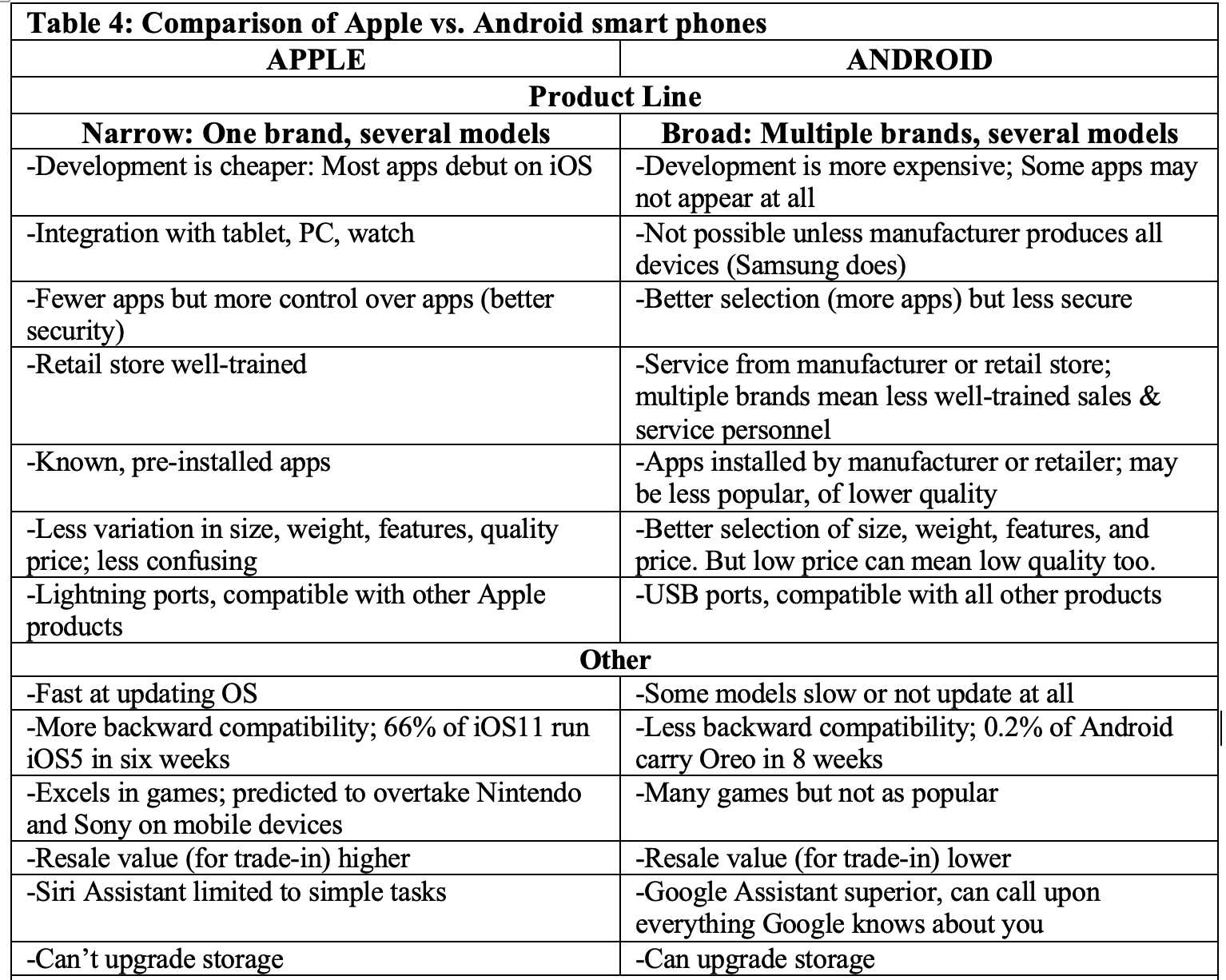Question
3.4.2 Elements of the iPhone Strategy In January 2007, Steve Jobs announced the long-awaited iPhone. In June, Apple sold 270,000 iPhones on the first weekend
3.4.2 Elements of the iPhone Strategy
In January 2007, Steve Jobs announced the long-awaited iPhone. In June, Apple sold 270,000 iPhones on the first weekend it was available41.
3.4.2.1. Technology: Better operating system than Symbian, Palm, Microsoft, Nokia, LG. In 2005, Apple announced a surprise: Mac OS X had retained the support for multiple hardware architectures that had been used by NeXT to rapidly target new business (because of its origins, NeXTSTEP was built as a highly portable system)13. Within six months, Apple began shipping Intel based Macs, and within a year was able to transition to its entire product line. Thus, Apple also announced that its new iPhone would also run a version of the operating system which Apple referred to as simply OS X. In contrast to Microsoft's NT and WinCE, the version of OS X used on the iPhone--and apparently also the new Apple TV--shared far more in common with the desktop Mac version, from its Mach/BSD kernel to its Cocoa development frameworks.
3.4.2.2 Technology: More memory than Palm, Microsoft phones. How can Apple squeeze Mac OS X into the iPhone? On a Mac, a minimal installation of OS X takes up at least 10 GB of disk space, and happily consumes all the RAM it can find. The iPhone doesn't have a hard drive at all42.
The latest smartphones typically have 128 MB of Flash RAM and 64 MB of RAM. It is likely that the iPhone has at least 256 MB RAM in addition to its 4 or 8 GB of Flash. It appears that its copy of OS X and installed apps are stored in Flash RAM and consume about 500 MB. That would leave around 3.5 GB for music, email, and other storage on the base model. That's 28 times the Flash RAM capacity that any common Pocket PC or Treo has. Clearly, Apple expects users to actually use the iPhone, not just carry it around as a status symbol or to keep IT staff busy.
Palm devices were originally designed to run using a very minimal amount of RAM. The original Newton-era Palm Pilots from a decade ago had .5 or 1 MB of RAM. By 2003, the Palm Treo 600 had grown to use 32 MB of RAM. Only 24 MB of that was actually available to the user; however, the rest is eaten up by the Palm OS itself. Installing an application such as the Documents to Go Office file reader ate up another 5 MB, leaving only 19 MB available. This relatively tiny bit of RAM isn't a huge problem for the Palm OS, because it can only run one application at a time anyway. In the Treo 650, Palm changed how RAM worked. It uses 32 MB of Flash RAM, and 32 MB of system RAM. The Flash RAM storage is analogous to a hard drive; it contains a 9 MB ROM image of the Palm OS, leaving around 23 MB for user storage. That was actually less available storage compared to the previous Treo 600 model it replaced. Other differences resulted in the same files taking up more space than they did before. The 32 MB of system RAM actually runs the OS and apps, like RAM in a PC. When starting up, the Palm OS uncompressed from an image in Flash RAM to consume around 15 MB of the system RAM, leaving a paltry 18 MB for all running applications, caches, and peripheral use including camera photos as they are captured.
The latest Palm 700p has 128 MB of Flash RAM storage built in, 60 MB of which is available to the user, and 64 MB of system RAM. No amount of SD cards could make the Palm Treo a fast, multitasking machine, however, its memory capacity and potential is artificially stuck in legacy. That helps to explain why Palm sold out to Windows Mobile.
WM/WinCE similarly used to store everything in system memory, like a big RAM disk. Powering off the unit off would destroy anything in memory, just as it would on a PC. In Windows Mobile 5, Microsoft introduced the Palm-like convention of persistent storage. Files are all stored in Flash RAM, and only copied into system RAM while running. When the device runs out of power, everything copied to Flash RAM is retained. Existing devices designed to run the previous Windows Mobile 2003 typically had no or very little Flash RAM. This prevents them from upgrading to Windows Mobile 5, which requires a certain amount of Flash RAM to run. Palm's Windows Mobile version of the Treo 700 has the same 128 MB of Flash RAM for storage, and 64 MB of RAM as the Palm OS version. Windows Mobile 5 similarly leaves about 60 MB of the Flash RAM disk-type storage available to the user. The HTC TyTN, Motorola Q, Samsung Blackjack, and other common Windows Mobile 5 Smartphone and Pocket PC devices all have around 64 MB of RAM, and 128 MB or more Flash RAM, a paltry amount compared to the iPhone's 4096 MB or 8192 MB of Flash RAM. Again, the iPhone is equipped to be useful.
3.4.2.3 Market segmentation. Prior to Apple's iPhone, the industry had been dominated by a "staid, corporate-led smartphone paradigm" focused on enterprise needs. Industry leaders Nokia and Motorola had been enjoying record sales based on fashion and brand name, not technological innovation43. In his 2007 Macworld Expo keynote presentation, Steve Jobs announced that Apple planned to take just 1% of the billion-unit mobile phone market. Apple may have been shooting for 1% of the "mobile market," but it really intended to capture closer to 15% of the smartphone market--more than Palm, RIM, and Windows Mobile combined--in its first year44.
Smartphones of the day were designed around carrier and business limits, resulting in low bandwidth and short battery lives. These phones were not designed to handle additional tasks beyond communication and basic functions. Indeed, smartphones marketed for business were often deliberately stripped of cameras or the ability to play music and games. And when then-CEO of Research in Motion Mike Lazaridis pried open an iPhone, his impression was of a Mac stuffed into a cellphone, as it used much more memory and processing power than the smartphones on the market at the time. Apple's iPhone design also contained one of the first multitouch capacitive touchscreens, along with a consumer-friendly design. Steve Jobs proclaimed in 2007 that the smartphone was not just a communication tool but a way of life.
3.4.2.4 Product line. Incumbents had catered to segments of the market by offering a large number of smartphone models (Nokia had 57 different models). However, this approach could be confusing to customers and could sap engineering resources. Thus, Apple deliberately simplified its product line, offering only one model per year, minimizing the decision-making process for the consumer by making things simple. The standardization allowed for ease of design, but it also enabled mass production, consistent with the mass market it had targeted. Finally, a carrier in France said that in their stores, the feature phone makers have as many as 25 different models of phones available. That makes it hard for staff to be really knowledgeable about all of them all of the time45.
One year after the Apple iPhone was introduced, Google began offering its Android OS to chip makers, handset manufacturers, and developers through the Open Handset Alliance46. In effect, the various feature phone ecosystem members that had had problems with the transition to smart phones were united in a strategic alliance (like the Symbian alliance?). Therefore, the competition between the different product line philosophies - one brand, several models (Apple) versus several brands, several models (Android) - continues to exist. The following recent research provides a more detailed comparison of the strengths and weaknesses of each approach.




Step by Step Solution
There are 3 Steps involved in it
Step: 1

Get Instant Access to Expert-Tailored Solutions
See step-by-step solutions with expert insights and AI powered tools for academic success
Step: 2

Step: 3

Ace Your Homework with AI
Get the answers you need in no time with our AI-driven, step-by-step assistance
Get Started


